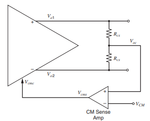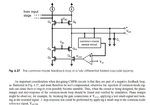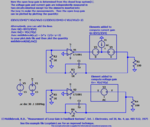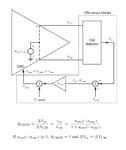Junus2012
Advanced Member level 5

Dear friends,
How can I simulate the stability common mode feedback loop in fully differential amplifier.
I need to measure the PM, GBW, and the closed loop gain of the CMFB loop.
You can use the attached image for your explanation please,
my idea is to apply an ac component to the VCM terminal and run the ac simulation to measure the transfer function from Vo1 or Vo2 then from there I get the needed parameters,
Please correct me if I am wrong or if there is better method

Best Regards
How can I simulate the stability common mode feedback loop in fully differential amplifier.
I need to measure the PM, GBW, and the closed loop gain of the CMFB loop.
You can use the attached image for your explanation please,
my idea is to apply an ac component to the VCM terminal and run the ac simulation to measure the transfer function from Vo1 or Vo2 then from there I get the needed parameters,
Please correct me if I am wrong or if there is better method

Best Regards







